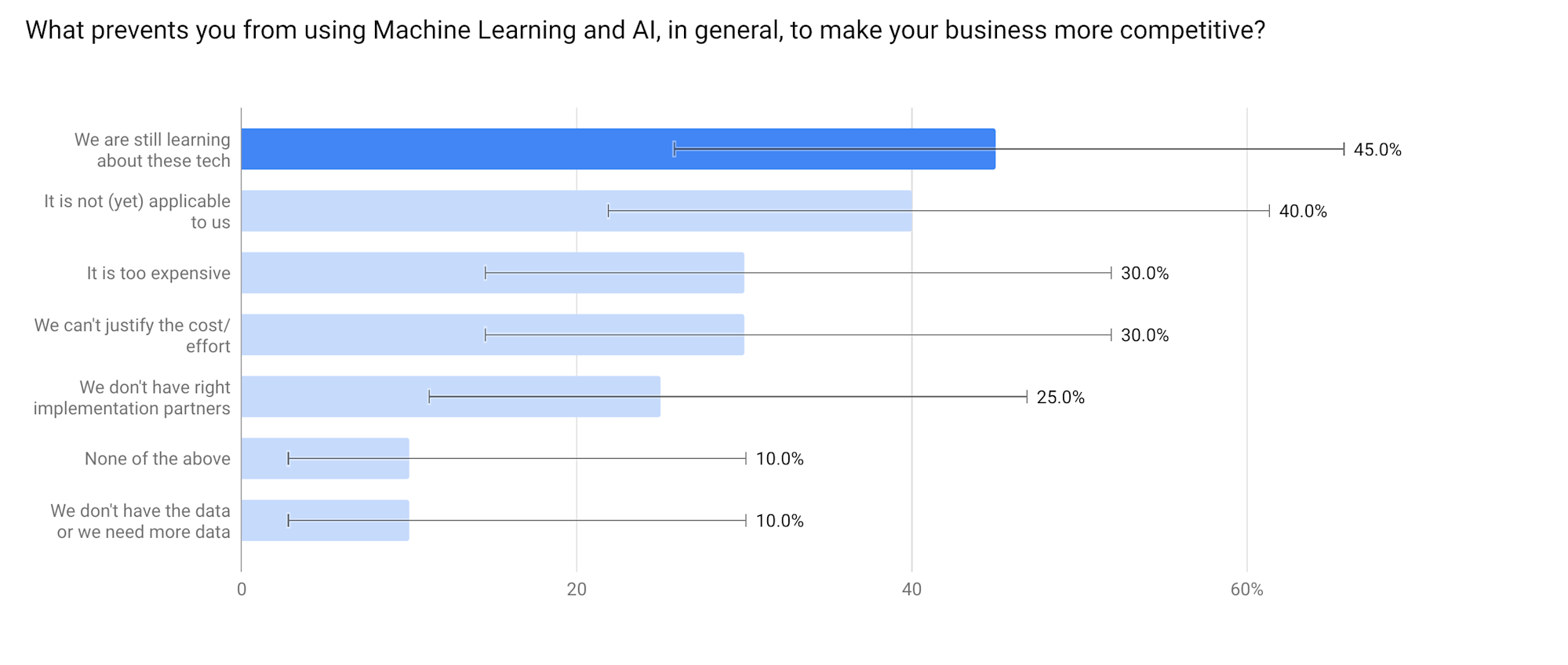Interviews
Q&A with Igor Mikhalev: Rethinking Business and UX with AI

Over the last few years we’ve seen many companies blindly follow various technology hypes like they’re the ultimate answer to making businesses future proof. Artificial intelligence (AI) and machine learning are currently receiving huge attention, but are they really such a game changer?
Companies often don’t have any idea how disruptive technology, like AI, could impact their customers’ experience and business, and they don’t have a clear understanding of its potential or its implications. That’s why we invited Igor Mikhalev from Firmshift, a data-driven technology development company, to answer a few questions about machine learning and AI.
After leading multiple scientific software development initiatives for industry leaders in knowledge extraction, scientific big data management and publishing, Igor Mikhalev completed his MBA at the University of Amsterdam (Amsterdam Business School). He now conducts his PhD research in collaboration with UvA and a number of organizations, all industry partners leading the way in data-driven R&D. As co-founder of development company Firmshift, Igor is also working on a number of transformational and AI-based development projects.
What drew you to the field of machine learning?
I love reinventing business models, ecosystems and customer experiences. AI and machine learning have exactly the potential to be the next level platform for the next wave of transformation.
The impact of these technologies is extremely profound in the societal sense and requires what we call the antidisciplinary approach to be successful. AI facilitates a natural, intimate, and timely transition in thinking across all domains I work with: technology, business, design, and science. It cuts across them.
AI and advanced machine learning allow us to work with high degrees of complexity, forms, and volumes of data across different disciplines to understand, learn, predict and then adapt. It enables our creations to act in ways that weren't explicitly programmed, which is critical for the new-generation solutions and research outcomes we’re delivering.
What excites you about AI?
Everything we have created as human beings, as a civilization, is the result of our intelligence. But at the same time, we have natural limitations in our reasoning and synthesis, and we tend to forget, become biased, and lose focus. What AI could do is essentially be a tool that helps us augment human intelligence, become more creative, and thus—hopefully—happier.
What’s your vision for the future of machine learning?
The field of AI and machine learning has been continuously evolving since it began in 1943. But, at the same time, machine learning—with its applied contribution to contemporary business—is yet to come of age. There’s so much excitement and interest, but also overheated expectations and confusion. It’s remarkable. Many of us have heard stories about startups and conferences getting decent funding just by mentioning a new “breakthrough” configuration of neural networks on a bunch of Powerpoint slides. However, I believe the amount of hype is proportional to the eventual outcome.
I don’t think I should be looking too far ahead, because it will most likely make any prediction of this kind pointless. However, talking about short to mid-term, I believe the focus will be on the ownership, sufficiency, and readiness of data, as well as organizational capabilities to nurture the creative process of working with internal and external data in the context of cross-functional business (model) innovation, supported by machine learning technology.
Data, the critical asset in this process, comes from ever-increasing amounts of content generated on the web by humans and connected devices: mobile, sensors, cameras, payment systems, and a huge array of other sources. Its value isn’t entirely understood yet, but I believe it will be one of the few ultimate competitive differentiators. Commonly accessible data will become increasingly commoditized, but value will likely reside with the owners of scarce data and the companies that interpret data in unique ways—and especially with providers of predictive analytics solutions that can develop successful models to transfer generated insights from one domain to others.
Do you think that, at some point, we’ll be able to trust AI entirely, or will the element of human control always be necessary?
You’re asking a very difficult question. I think we, as humans, only trust technology when it has been useful for a while, we understand how it works, and it causes us no distress. In the case of AI, it’s a bit different from conventional technology: it is, in a very general sense, an intelligent black box that in many cases prevents us from knowing the “how” part. So it gets very close to how humans operate and interact themselves. When do you trust another human? I suggest the trust is to be earned over time, just as in any personal relationship.
With this, AI challenges the relationship between human and machine. Not only because it lacks transparency and has a “mind of its own”, but also because it can take some of the existing activities and jobs traditionally performed by people. If we don’t know and do not explicitly control how it works, who takes responsibility for its mistakes? Its developers, data providers, or users? Should we even treat AI’s errors as mistakes? Maybe it’s “still learning”.
As with humans, AI systems should try to provide the best rationale as to how and why they arrived at a particular conclusion, so a human can assess it. A conversational interaction is probably the most suitable way of interrogating the machine learning model to explain a specific decision—that’s how it happens when you talk to a lawyer or a doctor.
We need to address the cultural, social, and ethical challenges that will arise as a direct result of the wider introduction of machine learning, probably by developing social and ethical roadmaps as impact analysis tools, and testing existing compliance laws. It opens a whole new dimension of legal and societal concerns, where the digital law and even digital philosophy can be the new disciplines that need development.
What advice would you give companies that want to start implementing AI in their business?
First of all, I want to share with you the results of our recent survey. Over 65% of participants communicated that machine learning is crucial in advancing the competitive capabilities of their companies—do or die!
However, generally speaking, companies have no idea where to start.

And I can understand that—it’s very difficult to navigate a field constantly disrupted by explosions of new information sources, hardware innovation driven by miniaturization of and increases in computer power, rapid evolution of machine learning tools, and the emergence of new and advanced algorithms.
First and foremost: don’t wait too long for technology to mature. Embrace the uncertainty, know your risks, and act today. Discover your data and play with it. Reach out to industry partners in the form of startups, independent consultants and academic partners and openly innovate together.
Don’t try to have your data science team figure out everything on their own: we’ve seen too many one-sided efforts like this failing miserably. Form a cross-disciplinary team instead, and include externals alongside your organization experts. Don’t forget about the role of designers and design thinking to transcend different realms of thinking and “speaking the same language”, e.g. between science and engineering or between engineering and design.
Work with your business domain experts to educate them and understand where AI-rich solutions could be developed to differentiate the company and contribute to competitiveness. Identify 5-10 viable and practical business scenarios during the next six months inspired by AI and machine learning and prototyping.
Work towards establishing a benchmark and see how your data performs in different machine learning scenarios against existing algorithms. Once you’ve established first results, build awareness and a clear business case to establish data science competency, and work with HR to start nurturing a data-driven culture that underpins its importance and usefulness. Ensure that AI becomes embedded in approaches, tools, techniques, and team competencies.
If you are considering buying over building, go for building—at least on some of your initiatives—because you want to learn. Choose projects that are going to form a new critical organizational competency or would be a critical differentiator for your business model. Pursue the buy option when available packaged applications are well-suited to your use case(s), and when cost and time are more important than the differentiation or customization of your machine-learning and data science solution.
What kind of responsibility does a designer have when designing AI?
Here we need to differentiate between designing conventional systems using AI, and designing AI itself. Designing AI would entail helping business, science, and engineering teams to think creatively, drive the cross-functional business (model) innovation process, challenge conventional wisdom, and become aware of the differences imposed by each other’s thinking realms. Visualization of ideas, brainstorming, and rapid prototyping, often facilitated by designers and delivered under design thinking methodology, would be central to the successful execution.
Designing systems using AI would mean assuming an exciting change—a dramatic extension—in a designer’s toolset: being able to use machines’ capabilities to read, comprehend, write, summarize, reason, listen and speak in combination with conventional design elements. It’s much harder than it sounds.
Designers will be able to create, deliver, and present content that’s hyper-relevant to the current context and user’s question manner across all channels. Non-visual aspects, such as empathy and tone of voice, can be adapted based on who the system is interacting with in order to maintain the optimal relationship with a user.
Most probably, as we did for usability in this conversation, we will have to redefine the meaning of “style” as a distinctive, aesthetically, and artistically advanced way of representing services with AI.
How does AI change user experience?
If we consider every UX interaction a dialogue with a specific purpose, then currently most of those dialogues are rather one-sided: a person is browsing a website or interacting with a service. They need to comply with how the system is designed and learn their way around its features, be it imperfections or a great piece of functionality.
So, until now, the concept of usability was defined by how fast a person can learn a service, due to its technology limitations. With AI I believe this concept is reversed: how fast a system can learn you. For instance, the AI can infer a reward-function that would represent the most successful outcome for you (or your archetype) given all constraints, experiences, and circumstances, like a state of mood. This reward-function can then be reverse-engineered to suggest the most optimal path to success, like having a question answered or a problem solved.
Elements of this path can be the most relevant to the specific situation and context medium of communication, a specific UX pattern, tone of voice, graphic design choice, type of a virtual assistant, and so on.
To summarize: AI-powered UX will augment our creative capabilities while helping us to deal with the ever-increasing complexity of digital products and usage scenarios.
This interview has been edited. If you want to know more about what AI or machine learning could do for your customers’ experience and business, get in touch with one of our human experts.